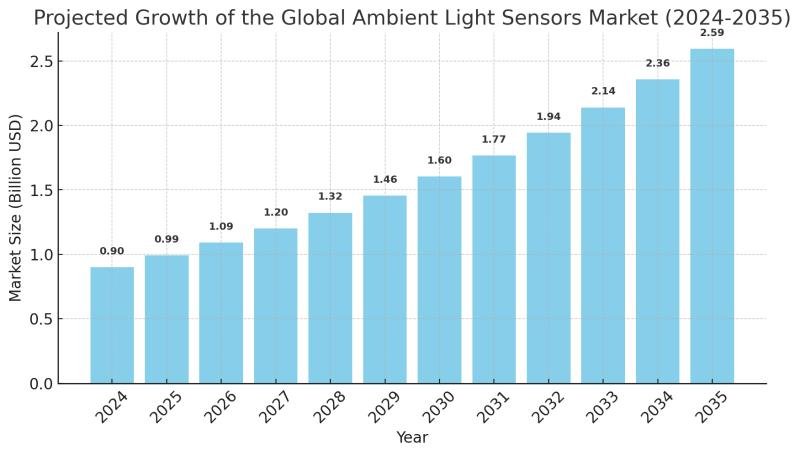The global ambient light sensors market is witnessing robust expansion, driven by unprecedented demand for smart technology and energy-efficient solutions across industries. With the market valued at USD0.9 billion in 2024 and an anticipated CAGR of 10.1% from 2025 to 2035, industry experts predict that the market will soar to USD2.5 billion by the end of 2035. This press release outlines a comprehensive market overview, key drivers, restraints, segmentation, regional insights, and the future outlook that together shape the competitive landscape of ambient light sensor technologies.
Access key findings and insights from our Report in this sample – https://www.transparencymarketresearch.com/sample/sample.php?flag=S&rep_id=86484
Market Overview
The ambient light sensors market is undergoing significant transformation fueled by the need for smarter, more energy-efficient devices. These sensors-integral to modern electronic devices-facilitate dynamic adjustments in screen brightness, adaptive lighting in smart homes, and energy optimization in various consumer electronics. Dominant sensor types such as photodiodes, phototransistors, and photoresistors deliver diversified functionality. Notably, photodiodes are leading the market due to their superior sensitivity, high response speed, and compact design, which are critical for enhancing user experience in devices like smartphones, tablets, laptops, and wearables.
With continuous technological advancements and an evolving consumer electronics landscape, ambient light sensors are becoming a vital differentiator for manufacturers. By integrating these sensors into their devices, companies not only elevate performance but also address increasing consumer demand for energy-saving solutions and user-friendly interfaces.
Market Drivers & Trends
Growing Adoption in Consumer Electronics
Consumer electronics are at the forefront of the ambient light sensors market. With rising awareness of power consumption and battery longevity, manufacturers are increasingly embedding these sensors to manage screen brightness dynamically. Modern smartphones, for instance, benefit from automatic brightness control, ensuring optimal readability while reducing energy usage. Wearable devices, including smartwatches and fitness bands, are also adopting ambient light sensors to provide improved user experiences both indoors and outdoors.
Expansion of Smart Home and IoT Applications
The integration of ambient light sensors within smart home ecosystems and Internet of Things (IoT) devices is significantly accelerating market growth. Smart homes equipped with automated lighting systems benefit from sensors that adjust indoor illumination based on ambient conditions. This not only enhances energy efficiency but also improves the overall comfort and convenience of living environments. Furthermore, the rise of voice-controlled smart assistants and mobile applications enables homeowners to manage and customize lighting effortlessly, further driving the adoption of ambient light sensor technologies.
Technological Innovation and Research & Development
Steady investment in research and development is yielding advanced ambient light sensing technologies that meet the evolving demands of consumers and sustainability requirements. Manufacturers are focused on producing smaller, more efficient sensors without compromising functionality. This trend is exemplified by recent product launches and technological breakthroughs, positioning ambient light sensors as a core component in next-generation consumer electronics and smart home devices.
Market Restraints & Challenges
Despite the significant growth prospects, several challenges remain. One notable concern is the potential cybersecurity risk associated with ambient light sensors. In January 2024, researchers at MIT’s Computer Science and Artificial Intelligence Laboratory (CSAIL) highlighted how these sensors could be exploited by hackers to capture sensitive information, such as touch inputs on smartphones. Such vulnerabilities underscore the need for robust security measures and continuous improvements in sensor technology to prevent potential breaches.
Another restraint is the cost factor associated with high-precision sensor manufacturing. As demand increases for miniaturized sensors that offer rapid response and high sensitivity, production costs can escalate. This, coupled with the need for extensive R&D to mitigate emerging security risks, may pose challenges for some market players, particularly those operating on tighter margins.
Key Players and Industry Leaders
The global ambient light sensors market is highly competitive, with key players investing heavily in product development, strategic partnerships, and mergers & acquisitions to strengthen their market presence. Leading companies include:
ams OSRAM AG
Analog Devices
Bourns
Broadcom
Honeywell
Infineon Technologies
Maxim Integrated
NXP Semiconductors
ON Semiconductor
ROHM Semiconductor
Sharp
STMicroelectronics
Texas Instruments
Toshiba
Vishay Intertechnology
These industry leaders are continuously expanding their product portfolios and investing in innovative solutions. For example, in August 2021, ams OSRAM AG launched an ultra-small ambient light sensor with UVA detection, designed specifically for wearable devices. This innovation allows smartwatches to alert users when the ambient UV-A dose exceeds safe limits, enhancing both health and safety features.
Review our report to gain deeper insights and understanding – https://www.transparencymarketresearch.com/ambient-light-sensors-market-report.html
Recent Developments
Recent developments have reinforced the potential of ambient light sensors. In January 2024, a study by MIT CSAIL warned of the cybersecurity implications of ambient light sensors in smartphones, urging manufacturers to prioritize data security. This research has catalyzed efforts across the industry to integrate advanced security protocols within sensor designs.
Additionally, strategic product launches such as the ultra-small ambient light sensor with UVA detection by ams OSRAM have underscored the evolving application landscape of these sensors. Such innovations not only bolster the functionality of consumer devices but also expand the usage scenarios of ambient light sensors into health monitoring and safety applications.
Market Segmentation
The ambient light sensors market is segmented by type, output, mounting, and industry vertical, each offering distinct advantages and applications:
Type:
Photodiodes: Leading segment due to their high sensitivity and fast response times.
Phototransistors: Offer robust performance in varying light conditions.
Photoresistors: Provide cost-effective solutions for applications with less stringent performance requirements.
Output Type:
Analog: Commonly used in devices requiring continuous signal variations.
Digital: Preferred for applications that require precise, discrete data points.
Mounting Type:
SMD (Surface Mount Device): Favoured for modern, compact electronics due to ease of integration.
Leaded: Typically used in legacy systems or specific industrial applications.
Industry Vertical:
Consumer Electronics: Including smartphones, tablets, wearable devices, laptops, digital cameras, and television displays.
Automotive: Applications in automatic headlight control, interior lighting, infotainment displays, and instrument clusters.
Healthcare: Used in medical imaging systems, phototherapy devices, and surgical lighting.
Aerospace & Defense: Employed in cabin lighting, instrument displays, and passenger entertainment systems.
Retail: Enhancing window displays, POS systems, and indoor advertising.
Others: Including industrial and agricultural applications.
This detailed segmentation not only demonstrates the versatility of ambient light sensors but also highlights the potential for customization across various end-user applications.
Regional Insights
East Asia Leads the Market
According to recent analyses, East Asia dominated the ambient light sensors market in 2024 with a market share of 38.7%. This region’s leadership is driven by robust manufacturing capabilities, continuous technological innovation, and a rapidly growing demand for smart devices. Countries such as China, Japan, and South Korea are at the forefront, benefiting from well-established supply chains and significant investments in R&D.
North America and Europe
North America and Western Europe are also key markets for ambient light sensors. In these regions, strong consumer demand for energy-efficient electronics and the rapid adoption of smart home technologies contribute significantly to market growth. Additionally, ongoing collaborations between local manufacturers and global technology giants are expected to further enhance the deployment of advanced sensor technologies.
Emerging Markets
Emerging regions such as South Asia, Central and South America, and the Middle East and Africa are witnessing increased adoption of ambient light sensor applications. As these regions expand their infrastructure and technological capabilities, they are poised to become important contributors to the global market, particularly in consumer electronics and automotive applications.
Future Outlook
The future of the ambient light sensors market is bright, with several trends poised to drive growth:
Technological Advancements: Continuous improvements in sensor sensitivity, miniaturization, and integration with smart devices will pave the way for next-generation ambient light sensors.
Increased Security Measures: In light of recent cybersecurity concerns, manufacturers will prioritize the development of robust security features to protect against potential threats.
Expanding Applications: The integration of ambient light sensors with smart home, IoT, automotive, healthcare, and aerospace systems will broaden their usage scenarios, driving market penetration across diverse sectors.
Sustainable Innovations: With a growing emphasis on energy efficiency and sustainability, ambient light sensors will play a pivotal role in reducing power consumption across various applications, contributing to greener technologies.
Analysts anticipate that these factors will not only sustain current market momentum but also unlock new growth avenues, positioning ambient light sensors as a cornerstone in the evolution of smart technology ecosystems.
Buy this Premium Research Report to access comprehensive analysis – https://www.transparencymarketresearch.com/checkout.php?rep_id=86484
Explore Latest Research Reports by Transparency Market Research:
Synchrophasors Market: https://www.transparencymarketresearch.com/synchrophasors-market.html
Surge Protection Devices Market: https://www.transparencymarketresearch.com/surge-protection-devices-market.html
About Transparency Market Research
Transparency Market Research, a global market research company registered at Wilmington, Delaware, United States, provides custom research and consulting services. Our exclusive blend of quantitative forecasting and trends analysis provides forward-looking insights for thousands of decision makers. Our experienced team of Analysts, Researchers, and Consultants use proprietary data sources and various tools & techniques to gather and analyses information.
Our data repository is continuously updated and revised by a team of research experts, so that it always reflects the latest trends and information. With a broad research and analysis capability, Transparency Market Research employs rigorous primary and secondary research techniques in developing distinctive data sets and research material for business reports.
Contact:
Transparency Market Research Inc.
CORPORATE HEADQUARTER DOWNTOWN,
1000 N. West Street,
Suite 1200, Wilmington, Delaware 19801 USA
Tel: +1-518-618-1030
USA – Canada Toll Free: 866-552-3453
Website: https://www.transparencymarketresearch.com
Email: sales@transparencymarketresearch.com
This release was published on openPR.


















